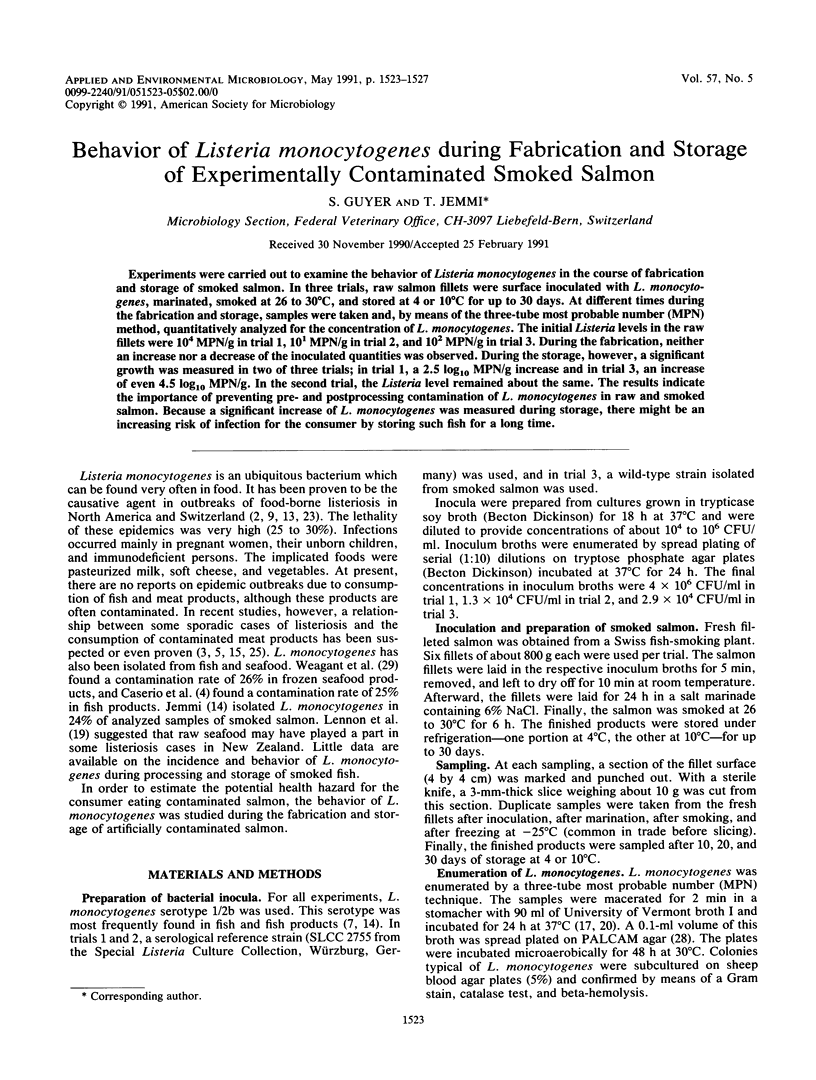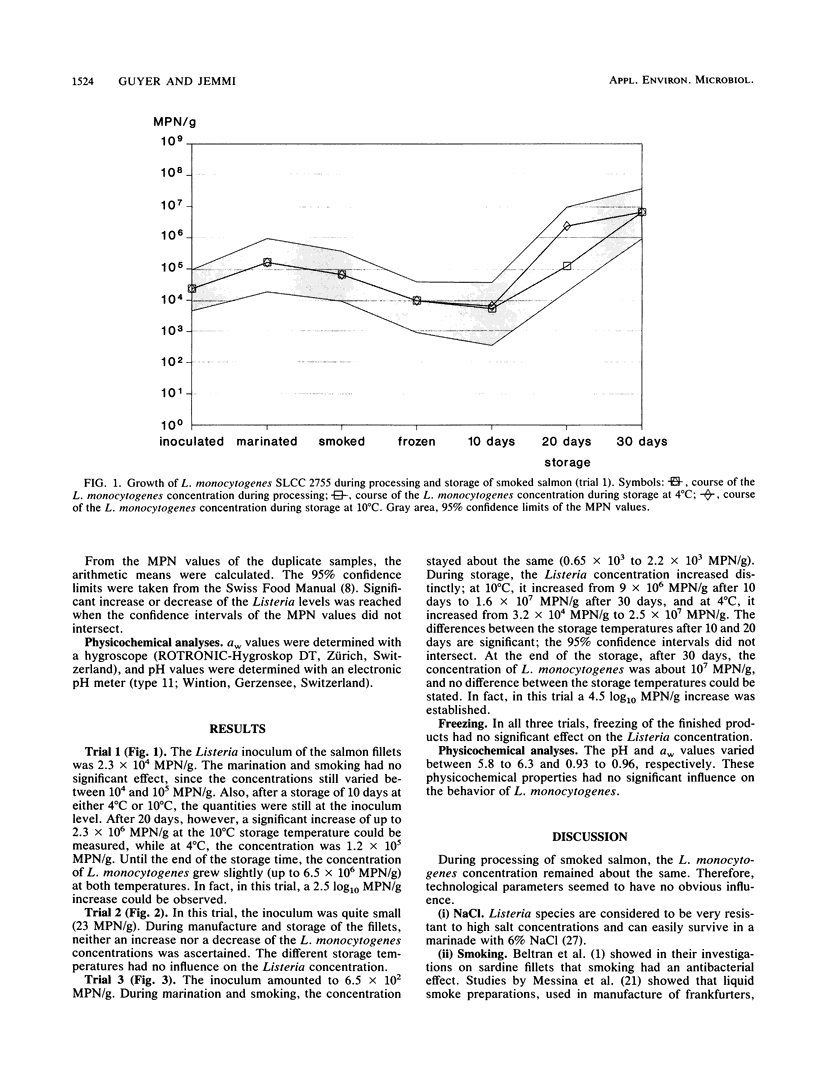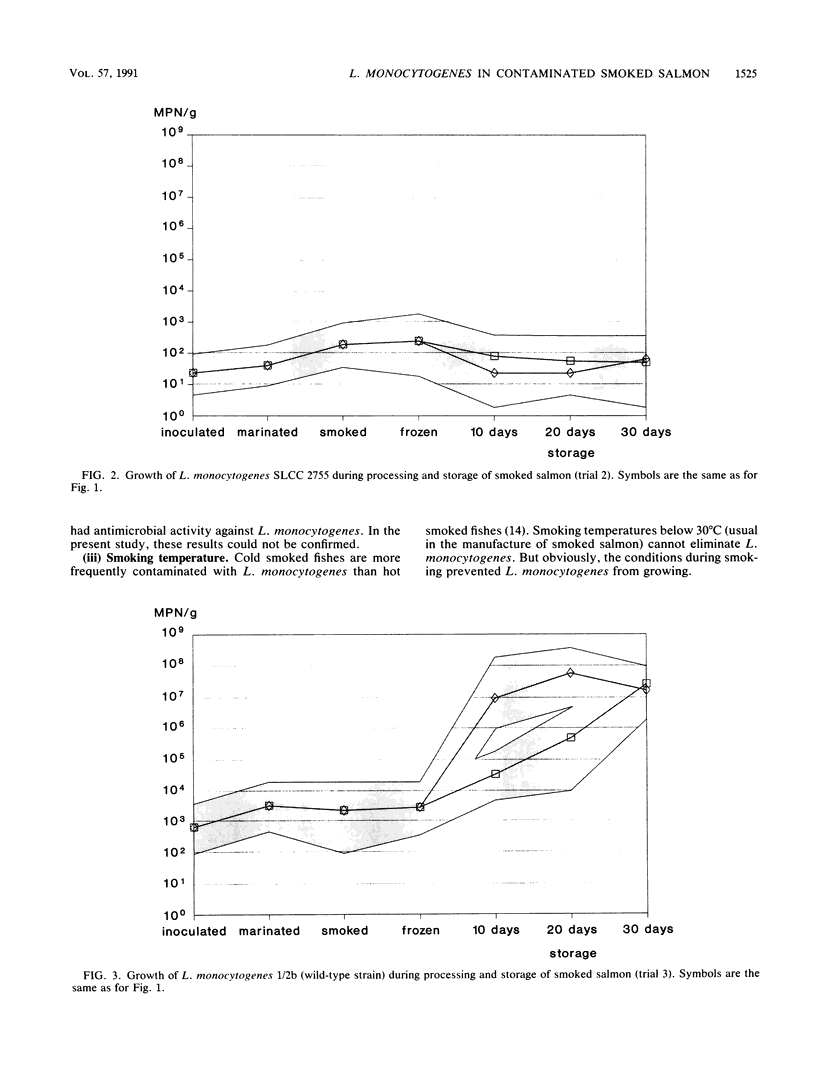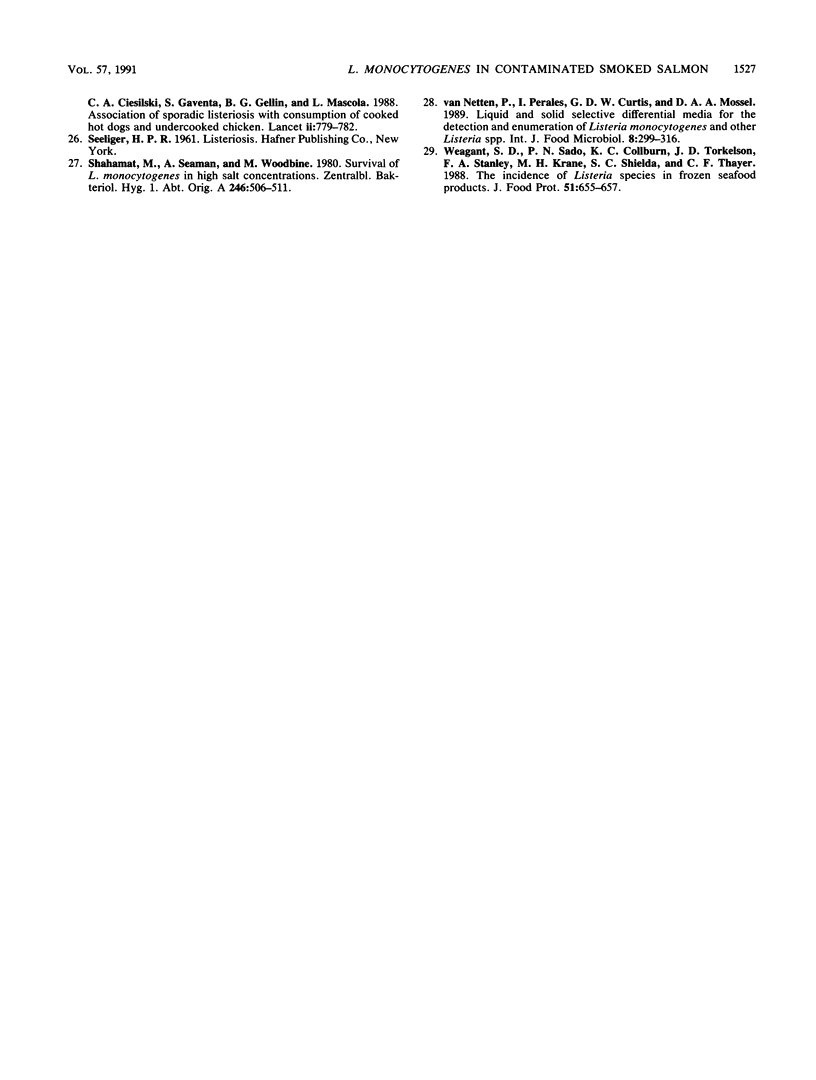Abstract
Experiments were carried out to examine the behavior of Listeria monocytogenes in the course of fabrication and storage of smoked salmon. In three trials, raw salmon fillets were surface inoculated with L. monocytogenes, marinated, smoked at 26 to 30 degrees C, and stored at 4 or 10 degrees C for up to 30 days. At different times during the fabrication and storage, samples were taken and, by means of the three-tube most probable number (MPN) method, quantitatively analyzed for the concentration of L. monocytogenes. The initial Listeria levels in the raw fillets were 10(4) MPN/g in trial 1, 10(1) MPN/g in trial 2, and 10(2) MPN/g in trial 3. During the fabrication, neither an increase nor a decrease of the inoculated quantities was observed. During the storage, however, a significant growth was measured in two of three trials; in trial 1, a 2.5 log10 MPN/g increase and in trial 3, an increase of even 4.5 log10 MPN/g. In the second trial, the Listeria level remained about the same. The results indicate the importance of preventing pre- and postprocessing contamination of L. monocytogenes in raw and smoked salmon. Because a significant increase of L. monocytogenes was measured during storage, there might be an increasing risk of infection for the consumer by storing such fish for a long time.
Full text
PDF




Selected References
These references are in PubMed. This may not be the complete list of references from this article.
- Beltrán A., Peláez C., Moral A. Keeping quality of vacuum-packed smoked sardine fillets: microbiological aspects. Z Lebensm Unters Forsch. 1989 Mar;188(3):232–236. doi: 10.1007/BF02112881. [DOI] [PubMed] [Google Scholar]
- Conner D. E., Brackett R. E., Beuchat L. R. Effect of temperature, sodium chloride, and pH on growth of Listeria monocytogenes in cabbage juice. Appl Environ Microbiol. 1986 Jul;52(1):59–63. doi: 10.1128/aem.52.1.59-63.1986. [DOI] [PMC free article] [PubMed] [Google Scholar]
- Fielding R. Self-control training in blepharospasm. Lancet. 1989 Mar 11;1(8637):548–549. doi: 10.1016/s0140-6736(89)90083-4. [DOI] [PubMed] [Google Scholar]
- Fleming D. W., Cochi S. L., MacDonald K. L., Brondum J., Hayes P. S., Plikaytis B. D., Holmes M. B., Audurier A., Broome C. V., Reingold A. L. Pasteurized milk as a vehicle of infection in an outbreak of listeriosis. N Engl J Med. 1985 Feb 14;312(7):404–407. doi: 10.1056/NEJM198502143120704. [DOI] [PubMed] [Google Scholar]
- Glass K. A., Doyle M. P. Fate of Listeria monocytogenes in processed meat products during refrigerated storage. Appl Environ Microbiol. 1989 Jun;55(6):1565–1569. doi: 10.1128/aem.55.6.1565-1569.1989. [DOI] [PMC free article] [PubMed] [Google Scholar]
- Gouet P., Labadie J., Serratore C. Development of listeria monocytogenes in monoxenic and polyxenic beef minces. Zentralbl Bakteriol Orig B. 1978 Jan;166(1):87–94. [PubMed] [Google Scholar]
- Lee W. H., McClain D. Improved Listeria monocytogenes selective agar. Appl Environ Microbiol. 1986 Nov;52(5):1215–1217. doi: 10.1128/aem.52.5.1215-1217.1986. [DOI] [PMC free article] [PubMed] [Google Scholar]
- Lennon D., Lewis B., Mantell C., Becroft D., Dove B., Farmer K., Tonkin S., Yeates N., Stamp R., Mickleson K. Epidemic perinatal listeriosis. Pediatr Infect Dis. 1984 Jan-Feb;3(1):30–34. doi: 10.1097/00006454-198401000-00008. [DOI] [PubMed] [Google Scholar]
- McClain D., Lee W. H. Development of USDA-FSIS method for isolation of Listeria monocytogenes from raw meat and poultry. J Assoc Off Anal Chem. 1988 May-Jun;71(3):660–664. [PubMed] [Google Scholar]
- Schlech W. F., 3rd, Lavigne P. M., Bortolussi R. A., Allen A. C., Haldane E. V., Wort A. J., Hightower A. W., Johnson S. E., King S. H., Nicholls E. S. Epidemic listeriosis--evidence for transmission by food. N Engl J Med. 1983 Jan 27;308(4):203–206. doi: 10.1056/NEJM198301273080407. [DOI] [PubMed] [Google Scholar]
- Schwartz B., Ciesielski C. A., Broome C. V., Gaventa S., Brown G. R., Gellin B. G., Hightower A. W., Mascola L. Association of sporadic listeriosis with consumption of uncooked hot dogs and undercooked chicken. Lancet. 1988 Oct 1;2(8614):779–782. doi: 10.1016/s0140-6736(88)92425-7. [DOI] [PubMed] [Google Scholar]
- Shahamat M., Seaman A., Woodbine M. Survival of Listeria monocytogenes in high salt concentrations. Zentralbl Bakteriol A. 1980;246(4):506–511. [PubMed] [Google Scholar]
- van Netten P., Perales I., van de Moosdijk A., Curtis G. D., Mossel D. A. Liquid and solid selective differential media for the detection and enumeration of L. monocytogenes and other Listeria spp. Int J Food Microbiol. 1989 Jul;8(4):299–316. doi: 10.1016/0168-1605(89)90001-9. [DOI] [PubMed] [Google Scholar]


